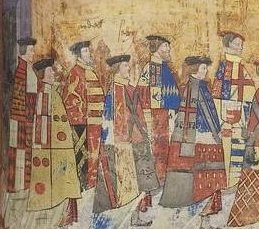
Henry Courtenay was cousin to Henry VIII – and a possible Yorkist claimant to the English throne.
Courtenay was a grandson of King Edward IV (through Catherine, Elizabeth of York’s youngest sister). Given this relationship, he had been “been brought up of a child with [Henry] in his chamber” and became one of his closest friends; when Henry and Charles Brandon went on their private hunting trips, Courtenay usually went with them. There was a bit of treason in his background (in that era, that kind of closeness to the throne made treason almost inevitable): in 1504, his father was arrested and attainted by Henry VII for allegedly corresponding with Edmund de la Pole, then the leading Yorkist claimant to the throne. But when Henry VIII’s acceded to the throne in 1509, he restored Courtenay’s title and even gave him some of the lands and properties forfeited by another cousin, Edward Stafford (the Duke of Buckingham).
Nominally, Courtenay was executed for his involvement in the Exeter Conspiracy, the name given to the plot to overthrow Henry VIII. That said, there was not a lot of evidence against him….beyond the fact that he had corresponded with Reginald Pole (you would think that his father’s example would have discouraged him from repeating the same fact pattern). But he should have known that few people aroused Henry’s ire quite like Pole did (I wrote a blog post about Pole’s refusal to return to England to face Henry’s wrath over his treatise, Pro ecclesiasticae unitatis defensione, which utterly rejected Henry’s position and denied the authority of the English church…). It also helped (or hurt, depending on how you look at it) that Courtenay and Thomas Cromwell hated each other, since many have floated the theory that Cromwell exaggerated the Exeter Conspiracy to remove several enemies (I touched on this in my blog post about Nicholas Carew’s execution).
Courtenay’s wife Gertrude, who had been arrested with him, was released about a year later. Their son Edward remained in the Tower until Mary I came to the throne. There was pressure on Mary to marry him, but that was never going to happen. Many people wanted to see him marry Elizabeth, but that too was never going to happen. There are some good stories there, and I promise to get to them – both here on the blog and in my next trilogy, about Elizabeth)! 😉
(PS – Henry Pole was also executed on this day – I’m saving his story for next year!)
***
If you like my posts, you’ll love my books! My Seymour Saga trilogy tells the gripping story of the short-lived dynasty that shaped the Tudor Era. Jane the Quene skews romantic, The Path to Somerset is pure Game of Thrones (without the dragons), and The Boy King is a noir coming-of-age. Get them now through Amazon, Barnes & Noble, Kobo, and Apple, or even your local independent bookstore!

(PS Already read them? Did you love them? Then please review them – even just a stars rating! It makes a huge difference in helping new readers find them and would mean the world to me!)

Instructive about how “best buddies” with power have treated one another. And reminds me that Trump’s frivolous condemnation of his former “best buddies” has an antecedent.
I can’t wait to see how a female in power changes the dynamic.
I love reading these vignettes!